Social Media is a foundation of business marketing. We use it to communicate, promote, engage and build relationships with our customers.
Its trick is that it’s all in the name – social media – it’s meant to be social: fun, entertaining, engaging and interactive. So how can you be these things with a business? It will look different in
your business to another regardless of your niche or industry.
The good news is that finding the balance to be social, whilst using it with a holistic approach to marketing doesn’t have to be confronting, confusing or pushed to the ‘too hard’ basket.
Use my top tips below to find the sweet spot of your branding with a social tone that your audience will be attracted to, whilst driving traffic to your website.

Clients always tell me they don’t want to show their face. Practice your smile in the mirror and just do it! Those who love your brand want to engage with you, so let them. If you have staff, share that spotlight around and include them in your stories and photos.
Look at what’s ahead each quarter as you’re likely to be inputting dates in this timeframe. Make note of events, promotions or activities that are on. Identify which ones you can leverage and set deadlines to write blog content to stand out from the crowd. Repurpose your blog on all platforms.
If you don’t host events or promotional campaigns, you can use industry calendars or social media dates the same way as using your own business calendar.
Set aside a couple of hours each month to write and schedule content or add to a spreadsheet for reference. Being persistent with social media is a game-changer! Layer batched content with photos and videos to add the fun in. I often see businesses focusing too much energy and budget on it instead of working it into their communication processes and overall strategy.

Kirsty Fields is Creative Director and Owner at Social Ocean, a marketing agency specialising in social media training for business owners and corporate events.
Harnessing social media for business from the very beginning, her passion is training clients in social media, event marketing and branding and seeking out unique event opportunities to promote her clients’ businesses to their communities.
Multi-award winning event manager, Kirsty writes blog articles to motivate and encourage business owners to use social media and improve and leverage promotional opportunities at events. In July, she was named as one of eight Female Thought Leaders by YMag.
Social Ocean was recently named one of 100 Federal Government Small Business Digital Champions project participants.
Social Ocean is everywhere online! Find them where you like to hang out the most: Facebook, Instagram, LinkedIn, Pinterest and Twitter.
Original article published in Issue 12 of Peninsula Life, September-October 2019. Peninsula Life magazine is a dedicated publication for the Redcliffe Peninsula, Queensland.
Kirsty Fields has over 20 years experience in the event management business. She has coordinated everything from kids’ events to national sports games. As an eager student of modern digital and promotional techniques, she has expanded her business into new areas of marketing expertise to offer her clients. She offers many types of workshops to help train companies in social media, digital marketing and branding, and can provide training to accommodate anyone.
YMag caught up with her to interview her for their issue featuring their Female Thought Leaders of 2019.
Below is the full unpublished interview with Kirsty Fields.
YMag – When did you start your business?
KF – My business evolved after a friend contacted me to ask if I could assist the professional teaching association she volunteered for, with their state-wide conference management. That was in February 2017. I was in shock after losing my job as a marketing manager at a private college which came from government changes in tertiary education fees. It was a pretty messy situation and I was still processing it all. At the same time, my husband was in the middle of negotiations for a job in Texas, USA – so I wasn’t actively job hunting. The thought of taking up a job when we were thinking of leaving the country didn’t sit well with me.
Assisting with conference management required me to have my own ABN and as a result of that process, my business was launched. I knew that there would be the inclusion of social media in my business after years of using it for business purposes, though it was quite unclear what it would look like. That was how Social Ocean started.
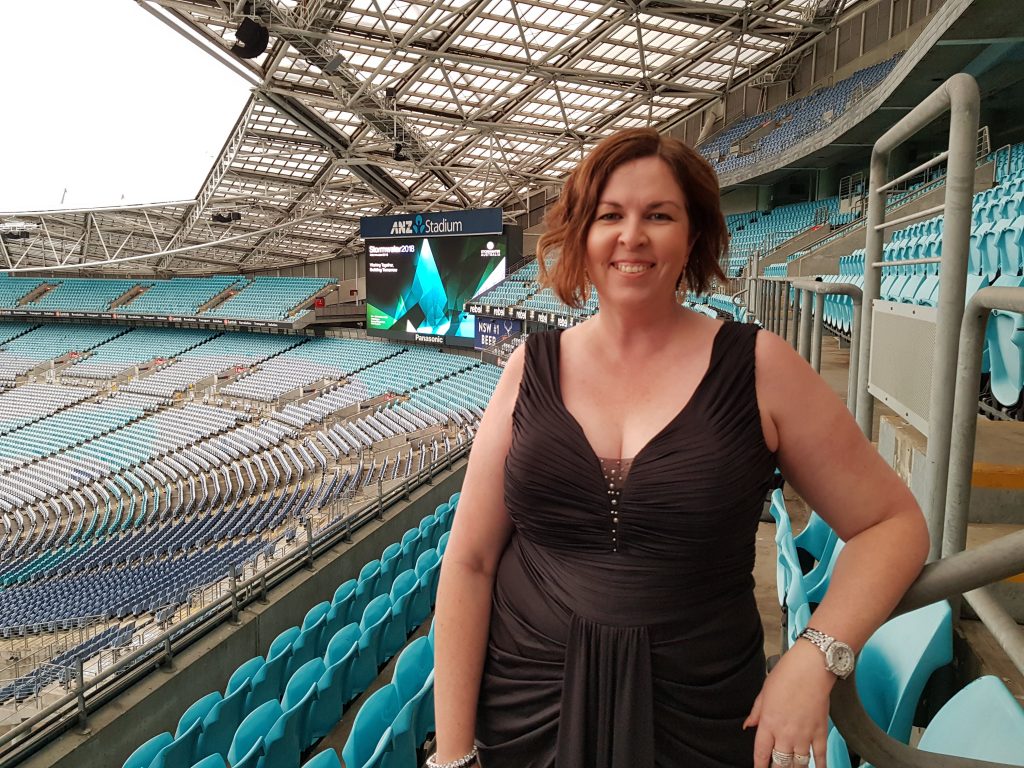
YMag – Why did you add events and social media services?
KF – Prior to my marketing management role I was a relations manager at the largest rugby league club in Queensland for eight years. I’d helped initiate, build and manage their digital and social media accounts to communicate with our National followers as well as players and families. Our platforms became integral in communicating with them about events on and off the field, weather, and so much more.
We tried out a variety of digital communication points to serve our fans and stakeholders. As a volunteer-based community however, it was easy for us to identify their potential as a marketing tool.
I was using Facebook from when it first launched, it became second nature to me. I had MySpace and various other accounts in my uni days, but nothing for business. Using Facebook specifically as a business tool was certainly not the intention or initial design.
I feel in love with the ability to ‘meet’ and reach others online with social media. But more than that, it because a way for me to sell tickets to events, invite people to support philanthropic activities and move them emotionally.
One year, I’d sold hundreds of tickets to a national rugby league game that had an extreme weather forecast. We had to scrap the event entirely as we weren’t able to bus the teams in due to flooding. Thanks to social media, we contacted thousands of fans preparing to travel through extreme conditions to watch their teams play. In less than 90 minutes, we’d been able to spread the word at three various levels of the game along with multiple other partnering sites who rallied to get the word out. It’s unfathomable to think just how many people will see your message.
It’s this passion and realisation of it’s power to assist business owners relay their message online, that meant I just had to have social media as a focus in my business.
Social media is also a key tool in Events Marketing. If you’re running an event – regardless of where, when or why – you must have an online presence for that event even if the event has no charge.
The events side of my business itself has been something that’s come naturally to me. I started managing events in the late 1990s and, with through career changes, my events experience also put me in a position to assist my employers along the way.
YMag – It sounds like you’ve been involved with lots of different event experiences, what are some of the most memorable ones?
KF – In 2016 I worked with the Queensland Police Service to launch a public campaign at a local sporting event. On the day we had police puppies, horses and the highway patrol cars all kitted out – combined with State Ministers, the Police Commissioner and various other government officials. It was a memorable occassion.
I enjoy providing clients with a different perspective. One of my client’s seminars are always held at a local pub, so guests can have a steak lunch with jugs of beer, allowing them to network more casually. Another client now has a successful trade component to their quarterly confrences, which has increased their revenue and built ongoing professional partnerships.
EVERY ONE OF MY CLIENT’S SUCCESSES IS MY SUCCESS – Kirsty Fields
YMag – Tell us about your workshops. What kind of programs do you offer?
KF – There’s different formats to my workshops, depending on the audience. I could be in a room full of managers from a franchise or particular industry or speaking at networking groups or conferences.
I run small group workshops a couple of times a year on various topics of social media and event planning. At the moment my most popular workshop topic is Content Creation. It’s where we sit in a quiet space and extract the business information from within you to recognise your original detailed content, ready to present online.
This year Canva, Instagram and LinkedIn are really popular too. Business owners are realising there are special techniques – hacks even, I love that word – they could understand to amplify their efforts in connecting with or attracting others.
YMag – Who are the people you work with in workshops?
KF – Most workshop attendees are sole traders in start-up and initial building phases of business. Having an intimate group scenario improves their comfort level as well as giving them a new opportunity to connect with their next collaborator or referral partner. Their incomes are yet to support outsourcing, but they are aware of the importance of activity online to create awareness and start new business friendships and collaborations.
I run my own events, just how I’d coordinate conferences, seminars or sales events for clients – bespoke in content and design.
YMag – What makes you passionate about what you do? What’s your Y?
KF – There’s something deep-seated in me about showing others that they don’t have to be rich financially to be rich in knowledge.
Further from that though you can have lots of knowledge, but I don’t believe everyone needs to “know it all”. I want to share with others what knowledge will be helpful to them, to make a difference in their businesses to help them succeed instead of overwhelming them with #allthethings. Let’s use what we need – not just what’s hot for a minute.
Every one of my client’s success, is my success.
There’s also something special about looking at the faces of those people who are attending events. They are there to inspire, educate and motivate themselves.
Corporate events can be different than coordinating “fun events” like weddings, engagement parties or 21st birthday parties. There’s almost always a strong educational element with workshops, seminars, trade expos and retreats. Though I attend a lot of events I always learn something new.
With my own events, I set a target for my delegates and guests to have more then one “light bulb moment”. I call it a “light bulb moment” because you see in the faces of these people when it happens – their eyes becomes wider and brighter, and it’s often joined by a smile. It’s a physical identifier to me that we’ve hit the mark – and it’s a priceless moment to me!
Plans for the Future…
My goals for the future are based on what I’ve learnt as a business owner. The first year was tough and I certainly couldn’t have survived without a second income in the house, but it taught me how to build a professional audience of my own, establish a referral network, connect with like-minded peers collaboratively and build a business from $1000. for 2019/2020, I’d like to show others how having a few dollars can create maximum impact and generate what success means to you.
My immediate goals as one of the 100 Small Business Digital Champions businesses from around Australia is to kickstart two online programs. One will support businesses with social media, and the other will support those looking to build their business using events. Social Ocean will be undergoing a digital transformation to support these programs and allow me to reach a national audience.
I don’t think I’m prepared to become an author – working with social media is always changing – so, by the time I published something, it’d be out of date. However, I have template booklets in the works. These are perfect for time-poor business owners who struggle to put time aside at the computer to plan their content.
It feels like a distant dream still, but I’d like the template booklets to lead into a social media planner for marketers, social media managers and business owners. There just isn’t one that combines social media with a great diary – it’s something I find myself searching for every November and December without success. I’d love to hear from other business owners if that’s something they feel would be useful.
An edited version of this interview was published in Issue 09 of YMag (July 2019).
Trade expos can be an excellent marketing activity and resource for connecting with new clients. But often companies get lost in the shuffle of eye-catching stalls and innovative exhibitors. You need to stand out, get the attention of your target market and, most importantly, get those warm leads to come to your stall.
So, what can you do to get noticed and approached by your target audience? Check off these twelve things before the day!
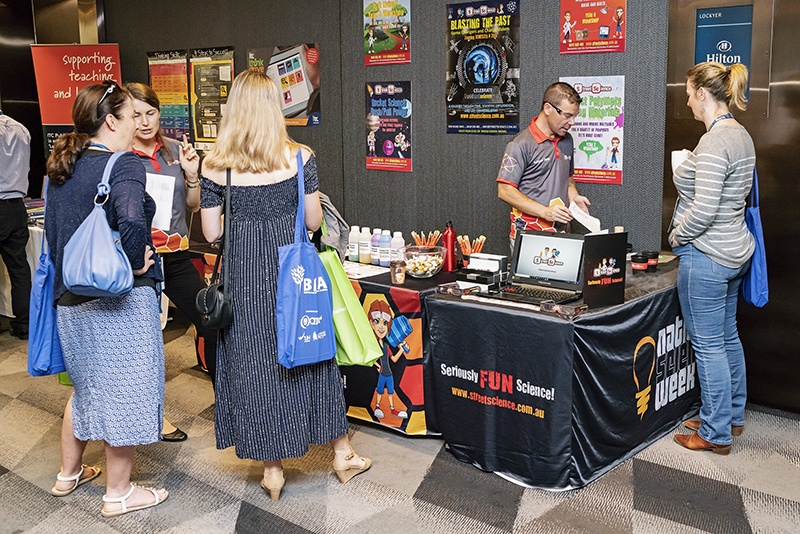
Signage with bang-on messaging is a must. Your name, and what you do must be absolutely clear. If you don’t let your audience know that you are offering what they need, they won’t know to stop by your stall. Clarity is essential.
And your signage must be visible above head height so potential leads can read your banner from a distance. This pulls an individual’s attention out of a fast-moving crowd and focusses them on you. It’s the first step in moving them toward you intentionally.
If your signage isn’t clear to the reader, they’ll walk past. And if it’s not visible, they’ll never even know you were there.
Once you’ve captured attention with good signage and a clear message, you may find you have more people at your stand than the number of staff available to chat during peak periods.
Waiting is boring, and when people have to wait to speak to you, there’s a risk they’ll decide to look at something else and come back later. This is not what you want. Instead, you want to keep the attention of waiting warm leads by placing interesting and informative elements on your tables or around your display. This could include, smaller signage, brochures, business cards, annual documents or magazines, special checklists or tear away forms. These are all usable marketing items which can be read while they wait to speak with you.
There’s nothing better than a moving visual element on a business trade exhibit. If you’re attending an event at a major conference centre and are allocated a booth, you’ll have space for a TV to play video or images on a loo. If you don’t have a large area, a laptop will do the trick as long as you can present it easily. And there are fabulous and fairly inexpensive iPad stands available from expo suppliers, should a tablet be the best option for you.
You can spend big on fancy equipment or put together a smaller, less expensive presentation method, but having a visual element is an excellent way to grab attention.
Consider having your visual element on a three-minute loop. One- or two-minute loops will run out quicker than you can wrap up a conversation. Keep your audience captive!
Venues vary greatly and each venue will have limitations with regard to the space, size and shape of your display. Find these out before the day of the expo. Even if you’ve been a stallholder at the event before, double check that nothing has changed.
Then, be flexible. Think how those limitations might be used to your advantage. If there are no walls around your stand, could you place seating for waiting guests, which would also delineate the area? Could you show a video in that section?
Each venue requires some adjustments and flexibility. Be creative, be innovative and keep asking yourself, ‘what would keep my guests here at my stall?’

If you’re a product-based business, bring boxes of product and display them as though you’re the perfume section at Myer. Be beautiful! Think luxury! Even if your business has a boho-vintage vibe, go boho-luxurious! Putting your best foot forward for product display is key as a trade exhibitor. You don’t actually have to sell your product on the spot. If your presentation is quality, people will be more likely to buy your product later, if not right now. And if they love your product, they’ll be back without you needing to chase them.

Competitions are the easiest ways to secure contact details from expo guests. Make entering the competition easy. Use a large container for business cards – think see-through Perspex boxes, a pretty glass bowl or an engraved ice-bucket. Use sign holders next to the container to list what the prize is and encourage stall visitors to enter.
It’s essential that the prize includes something tangible – a real prize – not just a prize of your time or a discovery session with your company. Think about what other items could be attractive to your target audience. Your book – or one you’ve found beneficial – a sample of your products, a gift voucher for your business or another, tickets to your next workshop or conference or even a professional service every business needs, such as design work or videography.
All of these will encourage warm leads to engage with you, meaning you’ll have more opportunity to engage with them in the future.
You have approximately two minutes to acknowledge someone before their patience runs out and they walk away. Plan and practice polite ways to pause your conversation with one person, so that you can address others visiting your table. Excuse yourself briefly with an easy, ‘Excuse me, I’ll just point these people in the right direction’ or, ‘Pardon me, while I let these people know I’ll be with them soon’.
Short, sharp (but polite) direction or acknowledgement to those waiting is invaluable in having them wait for you a little longer. It also reminds the person you are talking to that they aren’t the only person interested in chatting to you.
You also need to think about the conversations you are having. Some may be more worthwhile than others, and it’s important to determine that fairly quickly. It’s also essential to be able to gauge whether or not a long or complicated conversation should be put on hold for a follow-up phone call or a meeting away from the event. This way you don’t lose the next waiting lead, and can still nurture your new connection at another, more convenient, time.
If you have a lot of services or products in your business, ask a friend to help you out. You might want to offer a service exchange or simply pay them, but having two people on a trade expo stand is a must for major events.
There’s nothing worse than being underprepared, understocked or overwhelmed – all of which are regular problems for small businesses at expos. Remembering you have outlaid funds to exhibit at this event. Don’t waste the effort and resources you put into getting there by not being able to cope with enquiries on the day.
You also have the added bonus of being able to have lunch (you don’t want to be that person eating and talking to a potential lead) and toilet breaks, and even spend time visiting other stands yourself.
Expos are not easy for exhibitors. Standing up for hours on end is a hard task. But the last person you want to be, is the person seated with a phone in your hand, looking down. Keep the energy up. Don’t ignore the traffic flowing past you (and yes, I see these people at every expo). Keep standing, smiling and engaging politely with people who pass by or stop to chat.
Being a trade exhibitor is your opportunity to get yourself in front of new leads, present yourself well and represent your business and brand to hundreds of new clients (if not thousands at a major convention centre event). It’s worth pushing through any uncomfortableness.
Pre-plan your communication strategy with your new contacts from the expo. Don’t start sending an email a day for seven days. This will just annoy your new leads and ensure they unsubscribe and throw out your business card.
A simple, well-crafted and short communication following up is the best approach. You can give the results of your competition (if you’ve had one), or email a link to connect with you on LinkedIn, Facebook or Instagram, if you prefer. You might also send them a downloadable resource or a link to a video that reminds them of who you are and what you do. In every case, you must ensure that your communication is helpful and adds value and isn’t just spam.
Run a Facebook Live competition. Organise when you’ll do this before you send out your follow-up email (as above) and make sure to let your reader know how they can listen, and enter your competition (use your Facebook link to take them to your page directly).
If you run the comp a day after the email it allows time for it to be read and action to be taken by the reader. It also puts you front of mind as you’re now, quite literally, at the top of their Facebook or LinkedIn notifications.
Use LinkedIn to reach out to every person whose business card you received at the expo. Send a Connection Request and, when doing so, add a personalised note reminding them that you met at the event, and that you’d like to keep in contact. This technique means you’ve layered your emails and Facebook Lives with a professional and direct connection that you can foster further in the future.
How many times you get approached by visitors at a trade expo is completely up to you and the effort you put into your display before the day.
You control your destiny. Your trade expo success relies on you having more than a casual chat. Make genuine connections and provide marketing material or other collateral to those connections. But most importantly, you need to capture contact details from those people in return. This is the beginning of turning warm leads into engaged customers.
Before you invest in your next trade display stand, get an audit on your last results.
Speak to the Social Ocean team about your event outcomes, get creative with your call to actions and set up for success. Book an audit in today.
Getting people to attend corporate events, in what is fast becoming a flooded market of choice, is even harder.
Guests walking through the door has always been the hardest part of event management, but is the most important outcome of event preparation.
Event management takes ages in planning, logistics, marketing and implementing all of the elements you prepare. So why would you make a decision that results in a guest’s first impression of you a crappy one?
The first impression your guest makes of you and your event occurs upon arrival to the venue.
Therefore the most important decision in selecting your event is the selection of your event venue.
You’re probably thinking I’d never choose a crap venue to host an event. It’s likely however, that you have and weren’t aware of it, as it’s rare to think about your guest before they show up at the door (or registration table).
Take the host of an event I went to last year. She’s the inspiration for this article – unfortunately someone had to be – but I also have her permission in writing my story!
The event was a three-hour Masterclass for approximately 30 people and it was a ripper! The host has inspired more than this article in me, because she ran a ripper of a morning seminar.
But…
The venue of choice was a central Brisbane location, in Teneriffe. A well-off trending suburb of Brisbane. It has great coffee shops, beautiful tree-lined avenues and historical locations of interest.
You could, if it suited you, catch a ferry up the river and take the short walk to the hired rooms from the dock.
If you were looking to add some incidental exercise into your working day, you could have gotten off a transit bus about a kilometre and a half away and walked, city-cycled or lime-scootered from the main drag.
Doesn’t it sound idyllic? It sure does. But idyllic isn’t how I’d describe my commute to the Brisbane seminar.
I don’t live in the big city – I live in a city to the North of Brisvegas, and though we finally have the ability to boast our own train line, if you want to use it to get to the trendy suburb of Teneriffe you’d also need an additional mode of transport to cover the distance from the nearest train station in business attire.
As I don’t carry a pair of joggers in my handbag like those clever CBD savvy white collar workers whose commute includes a lengthy walk from “somewhere” every day, that one wasn’t an option I’d consider.
I’m a soft suburbs girl, who uses her GPS to take her door to door from the home office to any other location. I expect any other location to be close to the car door from which I then exit from. If I’m required to walk any kind of distance greater than 100 metres to access an event, I need to be prepared.
When I arrived on the block of the event with well over 15 minutes to spare, I was scoping out the uber-trendy coffee spots along the block and looking forward to picking up a caffeine hit after finding my park.
You may be able to imagine that by the time I’d driven past the venue four times looking for a parking location, that scoping out coffee shops became a distant memory.
I had in fact turned my attention to whether or not I should drive around the six blocks I’d just looped around one more time… or whether I would drive back home.
I might sound a little picky as I’d “only” been 15 minutes early and I “should” have been much earlier – but remember, I’m a soft suburbs girl where you can get a park anywhere outside of a Westfield shopping centre in the blink of an eye.
Add in the red line fever that starts to rise at the potential of being late, to anything. Yep, I’m one of those people. Ten minutes early is perfect timing for a three-hour seminar.
Here’s the problem IMO. This idyllic location doesn’t meet (my) event standards, because it does not provide parking for guests.
I’ll qualify this statement.
Catching a ferry isn’t a regular form of public transport for many.
I’ve literally never, ever in my life considered catching a ferry a form of public transport – not even remembering the time I organised a private sunset ferry trip along Sydney Harbour.
That day on Sydney Harbour required a bus pick up from the ferry terminal for the final stretch of our journey, as part of an atmospheric afternoon for my corporate group – it was not public transport.
If there isn’t a train station within 500 metres of your location (even if it’s beautiful tree-lined trendy street), a private or public parking facility should be considered a must to be available within this distance.
I didn’t just think about driving 45 minutes back out of the city. I started to head back home, when I found a shopping centre with paid underground parking facilities. It turned out it was 800 metres up the road.
Whilst walking this distance, I thought at least 50 times I should go back home and enjoy an early start to my weekend.
Until I was seated inside the venue, which I’d arrived at now ten minutes late, I was desperately trying to counter that attitude by repeating the words “This seminar is just what I need right now, it’s going to be great!”
I was thinking through that mantra at short intervals as my heels started burning inside my Winter boots. I was dressed for the city remember, I wasn’t prepared for walking an unexpected distance from a far and exotic car park.
To rub salt to my frantic, stressed out wounds, I was then walking past all the trendy coffee shops I’d scoped out whilst doing repetitive blockies for 15 minutes, but I was now too late to stop and order.
“So what?” Do I hear you say?
Here’s some great tips on how to avoid your guest from red lining with stress trying to get to you.
Help your guests to arrive in plenty of time with a good coffee in their hand. Don’t have guests regretting their investment in your event, or feeling disillusioned about the quality of your presentation for the next three – eight hours. Let their first impression of you – before they walk through the door by positive by:
If I’m due to be arriving for your event and available street parking is limited or you’re aware parking is non-existent – then this is an event a soft suburbs girl will need to be wearing joggers and active-wear for, and prepare mentally for incidental exercise. I’ll need to know this in advance, and it’s your job as the Event Host to tell me.
If you need help with choosing your next event venue selection or with any part of your Event Planning, find out how Social Ocean can help you here.
Hosting your own events? Want to start running corporate events to promote your business? Use the Social Ocean Event Checklists to help you get started on your event management success.
Is Your Profile Picture Holding You Back in 2025?
When was the last time you updated your social media profile photo? If it wasn’t in the past 12 months, then 2025 is your sign to do it — and do it properly.
At Social Ocean, we know that your first digital impression matters more than ever. That’s why we’ve elevated our offering to include a professional branding photography experiences that will combine with our other service packages, but more importantly than that – help you with your own DIY marketing. Whether you’re a business owner, entrepreneur, or working professional, this added bonus ensures you’re always putting your best face forward.
Let’s talk about why your profile photo matters right now, and what you can do about it.
Why You Need a Profile Photo Refresh
You may have grown your hair, gone platinum, embraced silver streaks, or picked up a fringe (hi, it’s me!). Maybe you’ve dropped 10kg, gained muscle, or simply feel more confident than ever.
Whatever your reason, it’s valid. But it also needs to be visible.
We LOVE seeing our clients and online community showing up as the most current version of themselves. We don’t care why you updated your look. But we do care that your digital image matches the amazing person you are today, and that it positions you professionally and authentically.
So before you hit upload on a new photo, or worse — keep using one from 2018 — run your image through our Top 5 Profile Photo Tips for 2025.
Your profile photo should match who someone would expect to see when meeting you in real life. Whether it’s at a networking event, client meeting, or business lunch — your image should help people spot you, not confuse them.
At Social Ocean, over 50% of our social media audit clients need immediate updates to their profile image and banner graphics. And it’s no wonder — your profile photo is the first thing people see on your timeline, comment threads, and inbox messages.
That photo needs to do one job: make people feel like they know you.
Even if your hair or face hasn’t changed drastically, time does funny things. If your photo is older than 12 months, chances are it shows. And no, a professional filter doesn’t fix that.
Age gracefully and professionally. A good headshot with natural lighting, clear eyes, and your real smile is worth more than a decades-old glamour shot. Our branding sessions are designed to capture your personality in the now — not pretend it’s five years ago.
Sunglasses, hats, filters, weird angles… they all create a barrier between you and your audience.
If you wear glasses for reading or vision — keep them on. They’re part of your look. But if you’re shielding your face, squinting in the sun, or hiding behind a selfie at a vineyard, save it for Stories. Your profile photo needs to connect, not confuse.
One person. One photo.
Your professional profiles shouldn’t include your spouse, your siblings, or your whole bridal party. Even your cutest pet should sit this one out. You don’t want people asking, “Which one is Kirsty?”
Even in a scenic shot, make sure you are clearly the focal point. A blurred background is fine — a blurred YOU is not.
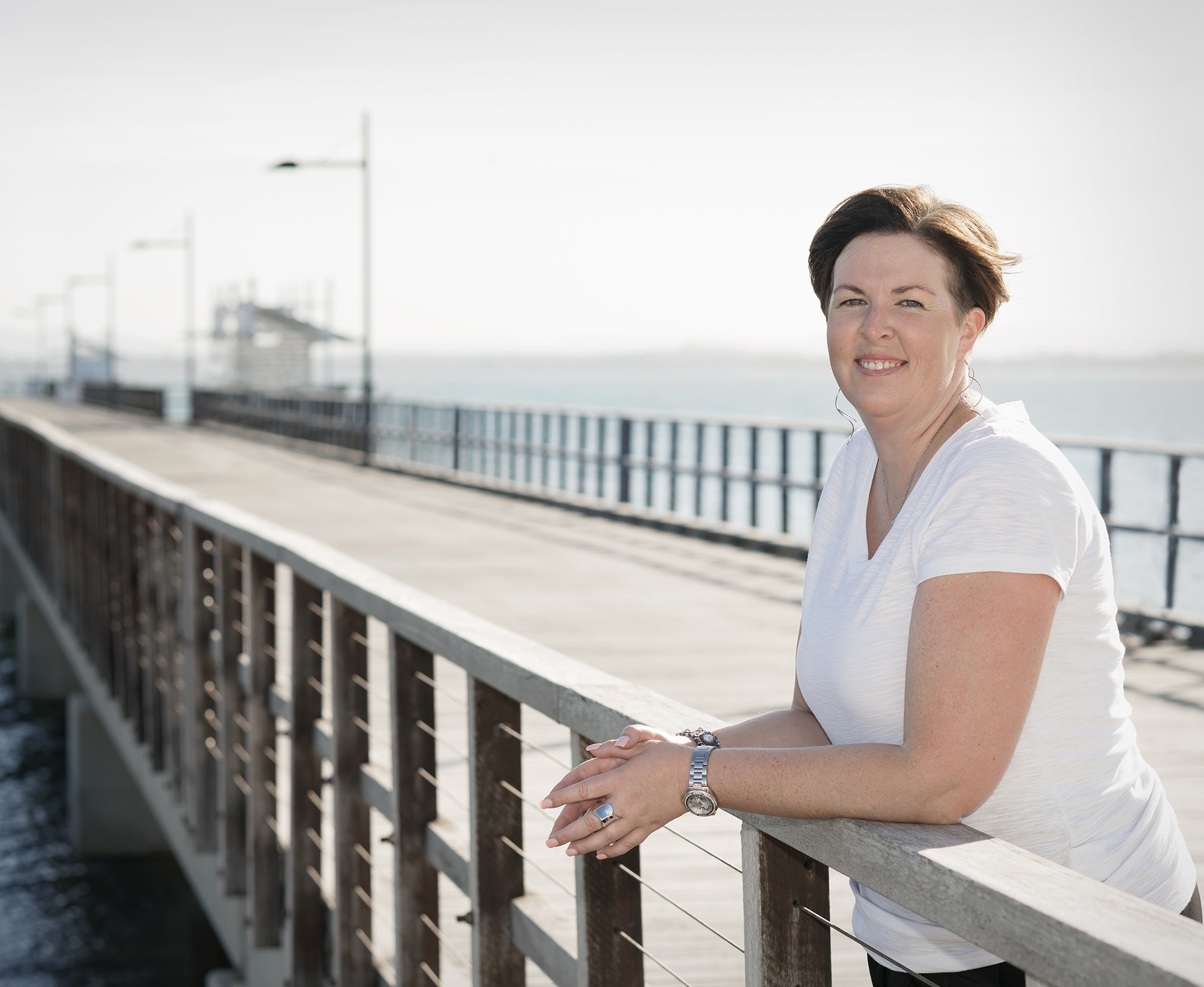
Ever tried uploading a great image only to crop your own head off in the preview box? Yep, us too.
The key is to start with a photo that has space around your head and shoulders — not one where your face is pressed to the frame. That way, you can centre your image in the circle crop of LinkedIn, Instagram or Facebook without losing scale or symmetry.
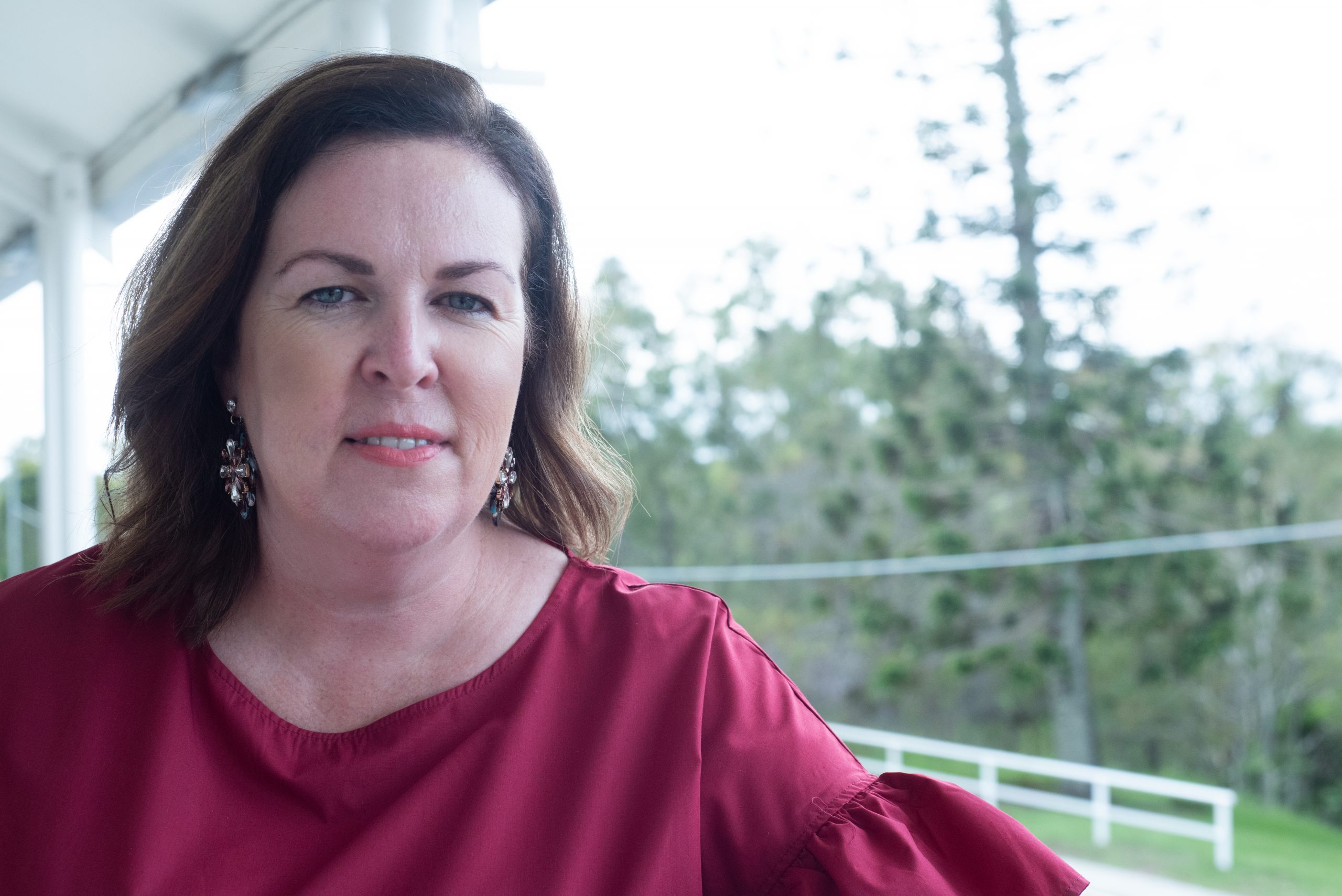
At Social Ocean, we’ve added a new layer to help our clients shine online all year round.
Our latest collaboration include a high-energy branding photography experience that will help give you the perfect image assets to use within your marketing. And yes this will meet all five of our profile image criteria above!
If you said no to even one of the above, it’s time to book your update.

Final Word: Your Face Is Your Brand
Whether you’re a coach, consultant, tradie, or team leader — your profile photo is one of the most viewed pieces of your brand identity. It’s the visual handshake of the digital world. Make it strong, clear and current. Don’t leave it to chance (or your camera roll). Book your professional branding photo session with Social Ocean and get the online presence you deserve in 2025.
➡️ View the current brand photography session: Visual Vibe Shoot
Here’s a shot from Candice Epthorp from a recent shoot. You can see that photographers will help you take shots that aren’t just for profile photography, making them the perfect addition to your social media schedule.
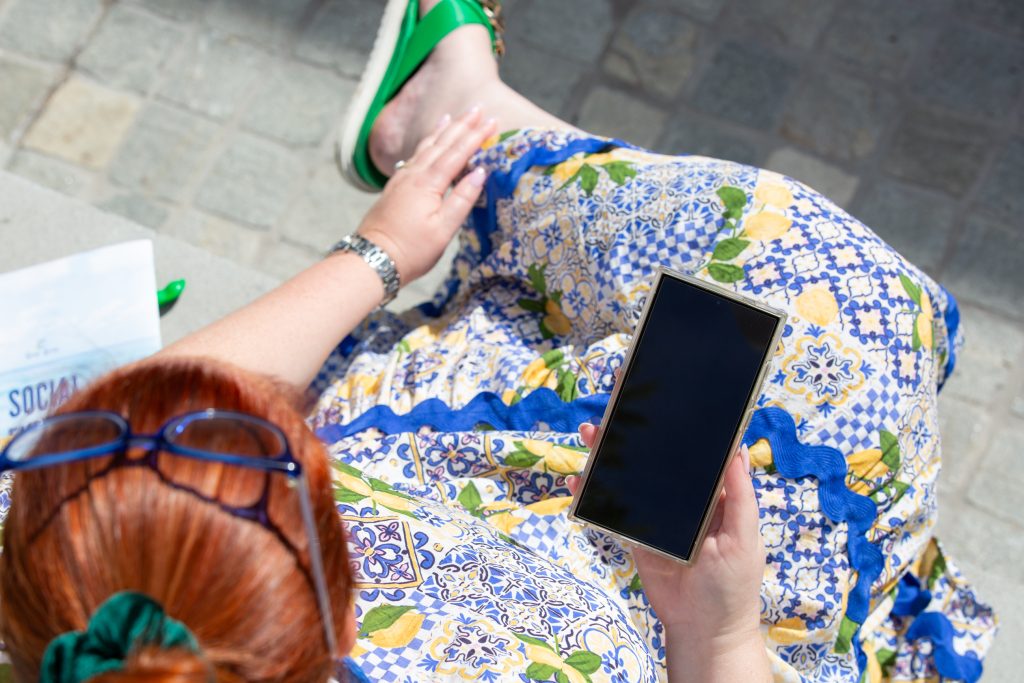
…..
2025 is full of platform updates, and LinkedIn hasn’t slowed down on its visual changes. Since Microsoft’s acquisition, LinkedIn has introduced several new features and improved user functionality across profiles, pages, and events. With those changes come frequent image dimension updates.
If you’re a business owner, marketer, or content creator managing a LinkedIn presence, especially through a Company Page, it’s critical your images are optimised for clarity, consistency, and compatibility across devices.
At Social Ocean, we stay ahead of the curve so you don’t have to. Here’s your up-to-date reference on LinkedIn imagery sizes for 2025, ready to plug into Canva, Adobe, or your design software of choice.
You’ve probably noticed the increasing number of tooltips and layout adjustments inside LinkedIn. These visual prompts are part of the ongoing enhancements that began rolling out in late 2024 and have continued through 2025.
While it’s great news for usability, these changes also mean your old image templates might now crop poorly or look blurry, especially on mobile.
💡 Our tip: Keep this blog bookmarked and revisit quarterly. We’ll keep it updated as the platform evolves.
Your personal profile is a key networking tool. Whether you’re a founder, thought leader, or employee, your visuals need to stand out professionally and consistently.
Here’s what you need:
Profile Photo:
400 x 400 pixels (square)
Make sure your face is centred and clearly visible.
Cover Banner:
1584 x 396 pixels (rectangle)
Use a clean landscape-style image. Avoid edge-aligned text or clutter.
Branding Tip: At Social Ocean, we often mirror the Company Page banner on the Personal Profile to build brand consistency across LinkedIn. It’s a subtle but powerful way to connect your identity with your business presence.
📸 Want tips on profile images? Check out our blog:
👉 5 Profile Photo Tips
Company Pages are essential for establishing authority, trust, and reach on LinkedIn. Your logo and banner are the first visual impressions.
Use these dimensions:
Company Logo:
400 x 400 pixels (square, for best clarity; minimum is 300 x 300)
Place your logo on a white background with generous white space.
Company Page Banner:
1128 x 191 pixels (wide rectangle)
Keep the design clean. Avoid placing important text or logos near the edges. Mobile cropping varies across devices.
💡 Pro Tip: Desktop and mobile crop your banner differently. We recommend not placing crucial design elements or text near the corners. Let your banner breathe. Simplicity always wins here.
LinkedIn Events continue to grow in popularity, especially for virtual and hybrid business activities. To make your events stand out, your event imagery needs to be bold, balanced, and optimised.
Use these dimensions:
Event Cover Photo:
1776 x 444 pixels (wide rectangle)
Centre your event name or branding in the middle third of the image to avoid it being covered by the event icon.
Event Logo (optional):
400 x 400 pixels (square)
Keep it crisp and simple. It sits over the cover image in some views, so avoid overlapping visuals.
You can recreate these exact sizes inside Canva by using the “Custom Size” feature or set up reusable templates in Adobe Illustrator, Photoshop, or InDesign.
And remember, if you need bespoke templates designed for your brand or want to outsource image creation completely, Social Ocean offers done-for-you Graphic Design services. Let us keep your LinkedIn and all social platforms looking slick and up to date.
📩 Contact us here to get started
Professional, correctly sized images on LinkedIn help your content get seen, your business look credible, and your brand feel cohesive.
Don’t let an outdated banner or fuzzy logo undermine your authority. Use this updated 2025 size guide to review your LinkedIn presence today. Make sure every image reflects the best version of you and your brand.
Article compiled by Kirsty Fields, Creative Director of Social Ocean
📱 Follow Social Ocean on LinkedIn and Instagram for more content tips and design resources
🗓 Last updated: July 2025
| Image Type | Dimensions (pixels) | Notes |
|---|---|---|
| Profile Photo | 400 x 400 | Square, clear headshot |
| Personal Banner | 1584 x 396 | Wide rectangle, no edge-aligned text |
| Company Logo | 400 x 400 (min 300 x 300) | Add white space around logo |
| Company Page Banner | 1128 x 191 | Avoid clutter, works across desktop & mobile |
| Event Cover Image | 1776 x 444 | Centre key text to avoid being cropped |
| Event Logo (optional) | 400 x 400 | Use simple design, minimal text |